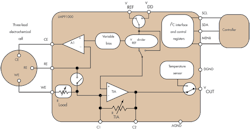We live in an analog world full of information useful to our civilization. We measure just about everything imaginable via sensors and convert the data into digital signals utilizing analog-to-digital converters (ADCs). In most cases, the output from sensors requires amplification and conditioning to provide the best possible signal to the ADC.
This combination of conditioning circuitry is called an analog front end (AFE). Sometimes this combination even includes the ADC. Sensor AFEs can be found in everything from personal health monitors to the enormous Large Hadron Collider sensor arrays.
Related Articles
- NRZ Vs. Multi-Level Signaling: Which Is More Efficient For Moving Bits?
- Industrial Environments Require Rugged Design
- LEDs Line Up To Replace Residential Incandescent Bulbs
The History Of The AFE
Electronic sensing of the world can be traced to the discovery of the photovoltaic effect by French physicist A.E. Bacquerel in 1839, along with the exploration of the pyro-electric and piezoelectric effects throughout the 18th and 19th century. As electronics matured in the early 20th century, these effects were crafted into sensors coupled to analog systems to measure and monitor a multitude of phenomena. Early systems were completely analog and found in medical monitoring, process control, and other industrial applications such as steel manufacturing and chemical plants.
With the advent of the IC microprocessor and later the invention of the DSP by Texas Instruments in 1978, the requirement to convert physical effects to digital signals became a focus for engineers. Integrated ADC technology was designed to convert a voltage (the analog signal) to digital bits.
Many precision ADCs use successive approximation registers (SARs) to slice the analog voltage latched on a sample and hold (S/H) into smaller and smaller pieces, yielding bits as the process proceeds. The delta-sigma method employs a modulation technique and a single comparator to produce a stream of digital bits, often in applications requiring a very large dynamic range, such as seismic detection of oil deep underground. Even high-resolution ADCs still require a voltage to convert.
This file type includes high resolution graphics and schematics.
Conditioning Sensor Signals
Engineers involved in sensing understood the limited output signals from many sensors and designed analog conditioning circuitry using operational amplifiers (op amps) and differential amplifiers to convert these tiny changes in the sensors to large enough signals to supply an ADC. This takes full advantage of the dynamic range of the ADC and helps maintain the signal-to-noise ratio (SNR). This circuitry also was used to compensate for offsets and other error sources, such as the cold junction temperature found in thermocouple applications.
Beyond the amplification and conditioning of the signal, filtering is required to remove unwanted signals from the system. Often, external electric fields impart noise into a sensor system such as the ubiquitous 50- and 60-Hz power-line noise, which can be heard in audio systems as a low-frequency hum. This electric noise can add significant error to a low-frequency signal from a sensor and must be either filtered or prevented (via shielding) from entering the system.
A major issue with ADCs is aliasing caused by frequency components present in the signal that are greater than the Nyquist Criterion (half the sampling frequency or Fs/2). If this occurs in a sampled system such as an ADC, the signals above half the sample frequency will be folded back or “aliased” into the first Nyquist zone (frequencies between dc and Fs/2). The higher-frequency components appear in the digitized output as lower frequencies, which could be confused with a real change in a sensor input. To prevent this phenomenon, an analog anti-aliasing filter is placed before the ADC input to remove frequencies above the Fs/2 point.
For most ADC architectures such as SAR, this filter can be challenging and may require several orders to provide the correct cutoff. Using oversampling, digital filtering and decimation can reduce the analog anti-aliasing requirements, but may increase power consumption.
For many sensor applications requiring a large dynamic range, delta-sigma ADCs are often used. These converters utilize a delta-sigma modulator to convert the analog signal into a digital count within a given interval, and they often run at many times the input frequency. This over-sampling allows quantizing noise to be pushed out of the band of interest. Filtering and decimating digitally then increases both the SNR and the usable dynamic range (often referred to as the effective number of bits, or ENOB). This configuration can greatly reduce the requirements of the anti-aliasing filter.
Sensor AFE Requirements
Many sensors require some form of excitation—that is, a signal that allows the sensor to provide a usable output. This signal may be a constant voltage or current, or even an ac signal such as a sine wave. Sensors that require excitation include resolvers, capacitive-based sensors (the capacitance changes as a result of the input to the sensor) such as proximity detectors, wideband zirconia sensors used in oxygen detection, and other electrochemical cells.
Along with the requirement to correctly digitize the output from the processed sensor signals, these types of cells require additional circuitry to allow the sensor to operate properly. Without the excitation signal, a sensor may provide incorrect readings or not work at all.
For example, electrochemical potentiostat cells work by the impedance change of an electrolyte as it comes in contact with a certain chemical or gas. Typically, these sensors have three connections: the counter electrode (CE), the reference electrode (RE), and the working electrode (WE).
In operation, current is driven into the CE connection and the circuitry monitors the voltage at the RE point. A closed-loop control circuit keeps this voltage constant, which in turn changes the return current present at WE. The resulting return current at the WE connection can be converted to a voltage via a transimpedance amplifier (TIA). The voltage between CE and RE, as well as the overall change in impedance (amount of current change at WE), varies from sensor to sensor.
To simplify the system design and provide sensor flexibility, semiconductor vendors have begun to integrate all of this front-end analog circuitry into a single device. For example, the LMP91000 is a fully integrated AFE for both two-wire and three-wire electrochemical sensors (see the figure). It is programmable via an I2C port to allow both the cell bias voltage (the voltage that appears between CE and RE) and the gain of the TIA that supplies the output voltage to the ADC to be altered. Its built-in temperature sensor helps adjust for drift in the electrochemical cell.
Many more of these sensor AFEs are tailored for such applications as automotive oxygen sensing, infrared absorption gas detectors, PH probe front ends, multi-wire resistive thermal devices (RTDs), strain gauges, and capacitive proximity sensors. All of these sensors have quite different requirements, and the availability of highly integrated analog sub-system front ends makes developing instrumentation far easier today than just a few years ago.
Conclusions
The world around us is analog, and converting physical phenomena to electronic signals requires a multitude of sensor technology. Many of these sensors require a significant amount of analog circuitry to operate properly. With the introduction of highly integrated AFEs, much of the hard work has been done. With the advances in micro-electromechanical systems (MEMS), entire sensor systems can be placed on a single device, such as pressure sensors where the sensing element is part of the die.
The near future will yield MEMS gas sensors—tiny little chemical laboratories on a chip that will take this integration even further providing everything on a single device. To keep our society safe, this technology along with other highly integrated sensors will find their way into our everyday lives beyond the common carbon-monoxide detectors found in many homes. Eventually, every smart phone will be equipped with gas sensors to alert users (and possibly first responders) of the environment around them. All of this will be possible due to advances in sensor technology and the AFEs that make them work.
Richard Zarr is a technologist at Texas Instruments focused on high-speed signal and data path technology. He has more than 30 years of practical engineering experience and has published numerous papers and articles worldwide. He is a member of the IEEE and holds a BSEE from the University of South Florida as well as several patents in LED lighting and cryptography.
This file type includes high resolution graphics and schematics.


